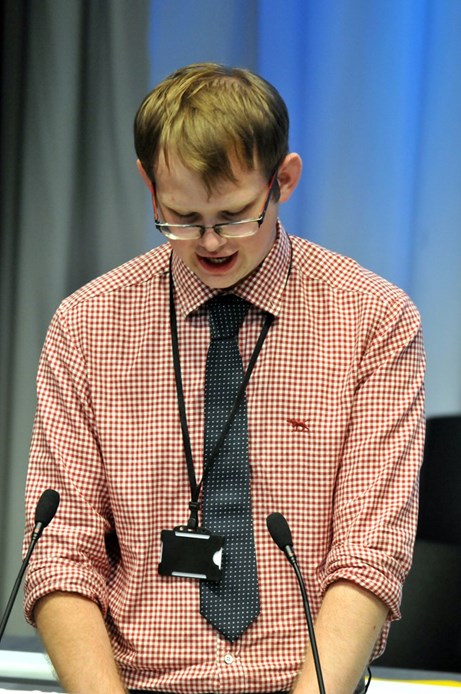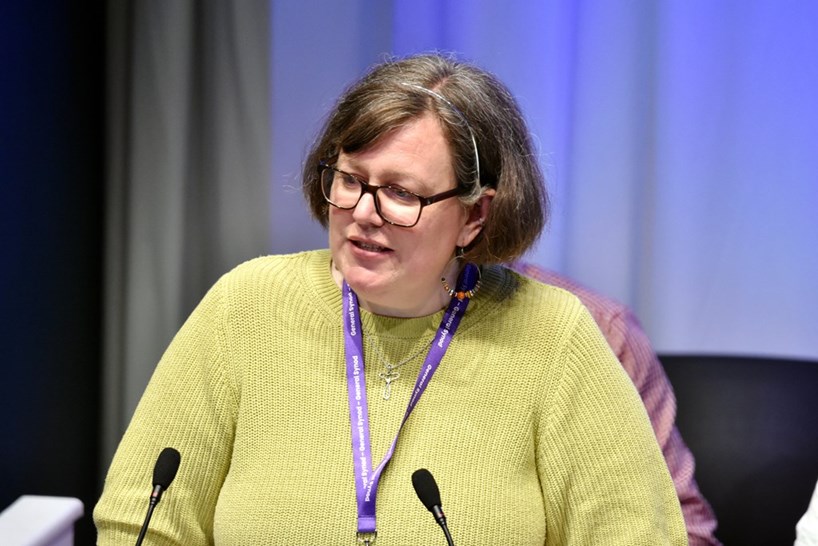A PANEL gave examples of church growth, during a presentation, introduced by Canon Kate Wharton (Liverpool) as “an opportunity to celebrate encouraging stories” on the Sunday.
A video presentation suggested that the Church was experiencing signs of renewal across a range of parishes, and that churches that invested in children’s and youth work tended to see growth. It also pointed to a growth in Bible sales, spiritual interest among Generation Z, and the “Way UK” social-media initiative, which had reportedly reached five per cent of all 13- to 17-year-olds in England. Social action often fuelled numerical growth, the Synod heard.
“Growth is not our achievement, but God’s gift,” Canon Wharton said. It mattered because “it is our heart’s desire that every single person would come to know the saving love of the Lord Jesus. . . We will try new things; we will step out. . . Lots of things will flourish and bear fruit. Lots will not, and that’s OK.”
It was not a competition, she emphasised. An older woman in her congregation, when asking about reports of a “quiet revival” among young people coming to faith, had told her: “I am going to look prayerfully on the bright side.”
The Archdeacon for Rural Mission (St Edmundsbury & Ipswich), the Ven. Sally Gaze, told stories of two people who had come to faith and joined churches. One, who had volunteered during the pandemic, said: “Knowing that God was behind it all made all the difference.” Another had attended a “Top Up Shop” in Ipswich, a foodbank initiative, and was now an evangelist serving as a PCC treasurer.
The Revd Christopher Trundle (London) is the Vicar of Holy Redeemer, Clerkenwell, in the Catholic tradition, which had become part of the Strategic Mission and Ministry Investment Board’s (SMMIB’s) Hackney and Islington Programme. This had been “really encouraging”, he said, referring to a “frank acknowledgement among lots of clergy in Stepney that a lot of our Catholic parishes were a bit fragile”.
Two new initiatives had been launched: a weekly 5 p.m. sung mass supported by the One Hope project, a Roman Catholic contemporary-worship movement, now attended by between 35 and 45 people, and Night Light, “a time of adoration of the Blessed Sacrament and a committed community of people praying in church and going out on to the street, inviting people to come into the church and light a candle”. It was not unusual to invite 100 people into church within an hour, he said.
SMMIB funding had provided accommodation for a curate and two lay workers. It was “important that we haven’t sought to dumb down or dilute our tradition. We have really leant into it.” The work was “not big, shiny, impressive”, but it was “really encouraging to see”.
Joel Plant (Leicester), one of the Synod’s new young-adults group, suggested that growth had come through 1300 young voices in termly diocesan listening exercises, to which bishops had to respond. Thirty per cent of UKME people who took part in the intercultural worshipping communities’ project in the diocese were under 18, he said. “Are we seeing young people more interested in faith? Maybe.”
The Church was certainly seeing “openness and curiosity about the Christian faith. They are open to trying prayer and talking about faith, as well as finding a place of belonging in different kinds of community.” Young people were looking for “worship experiences that allow them to express their faith authentically”.
 Sam Atkins/Church TimesWill Leeming (Blackburn)
Sam Atkins/Church TimesWill Leeming (Blackburn)
Alistair Bianchi (Durham), the Growing Churches Strategic Lead, celebrated that, after a 19-per-cent decline between 2019 and 2019, the diocese had reported growth of one per cent last year. “The shift is really significant. We are no longer in a momentum of decline.” Numbers at churches that had opted to work with his programme had grown by 11 per cent in the past year, he said. Children’s attendance had grown by five per cent, and by 29 per cent in churches that had received national funding. This followed a diocesan-wide decline of more than 30 per cent. “Every movement of God can be traced to a kneeling figure,” he said, quoting D. L. Moody
The Revd Fraser Oates (Worcester) served in Redditch, where his church was ten months into a SMMIB project. He was “acutely aware of a desire for sustainability, not just quick wins”.
The Bishop of Stepney, Dr Joanne Grenfell (Southern Suffragans), agreed that this was “really hard”. But she also had experience in both Portsmouth and Tower Hamlets of church growth being accompanied by giving, and that this had “buoyed up finances” in areas that were not wealthy. Giving had been “taught about from the very beginning”. Social enterprise had also played a part. She identified a “greater danger of not trying; and what we have seen in many of those contexts is the existing model of church does not stack up financially.” She acknowledged that, in the poorest communities, the work would never be entirely self-sustaining.
Will Leeming (Blackburn), also part of the Synod’s young adults’ group, came from a parish in a very rural area. He had asked his Vicar what the post of churchwarden entailed and had been told “not a lot really”. “I have since found out after my fourth year he might have just slightly over-exaggerated,” he said, prompting laughter from the floor. He enjoyed his responsibilities and said that young people needed to be involved in the day-to-day running of churches.
The Archdeacon of Lynn, the Ven. Catherine Dobson (Norwich), told several stories of the “amazing” way in which God was at work in her archdeaconry in many benefices, before revealing that all of them were currently in vacancy. “Rural may be small, but is it beautiful! And God can be found there.” She asked about how to best support churchwardens and other lay people during vacancies.
Archdeacon Gaze suggested that this group use the vacancy to “discover together who they are, so, when they write parish profile, it is accurate”.
The Revd Jody Stowell (London) asked what revitalisation looked like in smaller churches, most of which were not supported by central funding, but were “still vital in every sense of the word”.
Dr Grenfell emphasised that not all the work was “shiny. . . It’s really important that ordinary churches of all flavours and contexts can find their own way that God is calling them to mission and growth.” There was a need for much better partnership, including “focused work around back-office provision that can work across several parishes with economies of scale”.
There was also a need for “translation”, she said. “Sometimes, we can feel like we are talking about spreadsheets, outcomes, money. . . If we talk about vision that comes from God, and prayer and communities, and discerning where the Spirit is leading, and being attentive to the work of God, that gives us a set of disciplines that work in different contexts.” She urged people “not to react tribally or viscerally to the language”.
The Revd Dr Sarah Siddique Gill (UKME co-opted), who is Canon Missioner of Leicester Cathedral, told the Synod: “Small is not just small. It matters to God. The joy of the gospel is not reduced in those places. . . The tired bones need their joy, their uplifting, and assurance that God still loves us and is working.”
Canon Martyn Taylor (Lincoln) gave a market-town perspective on SDF projects. His church had planted into two churches in Grantham and Spalding. The former had grown from 20 to 125 people, after 40 people from the planting church had moved there. It was on track to be fully covering its own costs. Spalding had been sent eight people, and the church had grown from 45 to 100, with 15 children. There was “real traction” in market-town planting, he said: was there a national strategy for this?
 Sam Atkins/Church TimesCanon Kate Wharton (Liverpool) introduces the session as “an opportunity to celebrate encouraging stories”
Sam Atkins/Church TimesCanon Kate Wharton (Liverpool) introduces the session as “an opportunity to celebrate encouraging stories”
Eleanor Motion (Bath & Wells), another member of the young adults’ group, recalled being ask to help run a Sunday-school group as a 14-year-old, with a friend. “We were still figuring things out for ourselves and we were expected to lead. That was not easy and, looking back, I realise how important it is that young people are given space to grow and worship not just serve.” It was also important to think ahead about what would happen when children grew into young adults.
Professor Roy Faulkner (Leicester) expressed concern that “isolated SDF [Strategic Development Funding] success stories” had been “cherry picked, without considering the overall picture”.
William Woolley (Southwell & Nottingham) said that there was “fantastic news” of growth, including his wife’s work as a children and families worker, but that much of the discussion was about supporting clergy; lay leaders were being paid “significantly less” attention. Mental-health support was funded for ordinands, but not for lay workers, he said.
Archdeacon Gaze gave a warning against sharing the gospel with the sole intention of church growth — “a really selfish reason. . . If we are doing it because we love them . . . then that is a whole other thing.” There was a risk that little places — like a fresh expression which she had supported, not grown, but had helped many other places — may feel like they were failing, “but they may be doing exactly what God is calling them to do.”
Noah Chamberlain (Portsmouth), another member of the young-adults group, said that youth groups and events were “crucial, vital, paramount to the growth of faith in young people and hence the future of the Church. I would not be the person and Christian I am today without the multi-denominational youth group that I was part of.”
Clare Williams (Norwich) asked whether thought had been given to an assessment of growth across traditions, and correlating this with levels of resources given to those traditions.
Sarah Tupling (Deaf Anglicans) said that she had spoken to a mother with a deaf teenage daughter who had been unable to find a deaf church.
Bradley Smith (Chichester) referred to recent reports about the appeal of traditional worship to millennials. There were completely new congregations of all ages for which the 1662 Prayer Book was the norm. The congregation had doubled at one church in Lincoln since the Prayer Book was adopted, he said, and the young churchwarden was launching another initiative to emphasise the contemporary value of traditional worship and teaching.
Read more reports from the General Synod digest here














